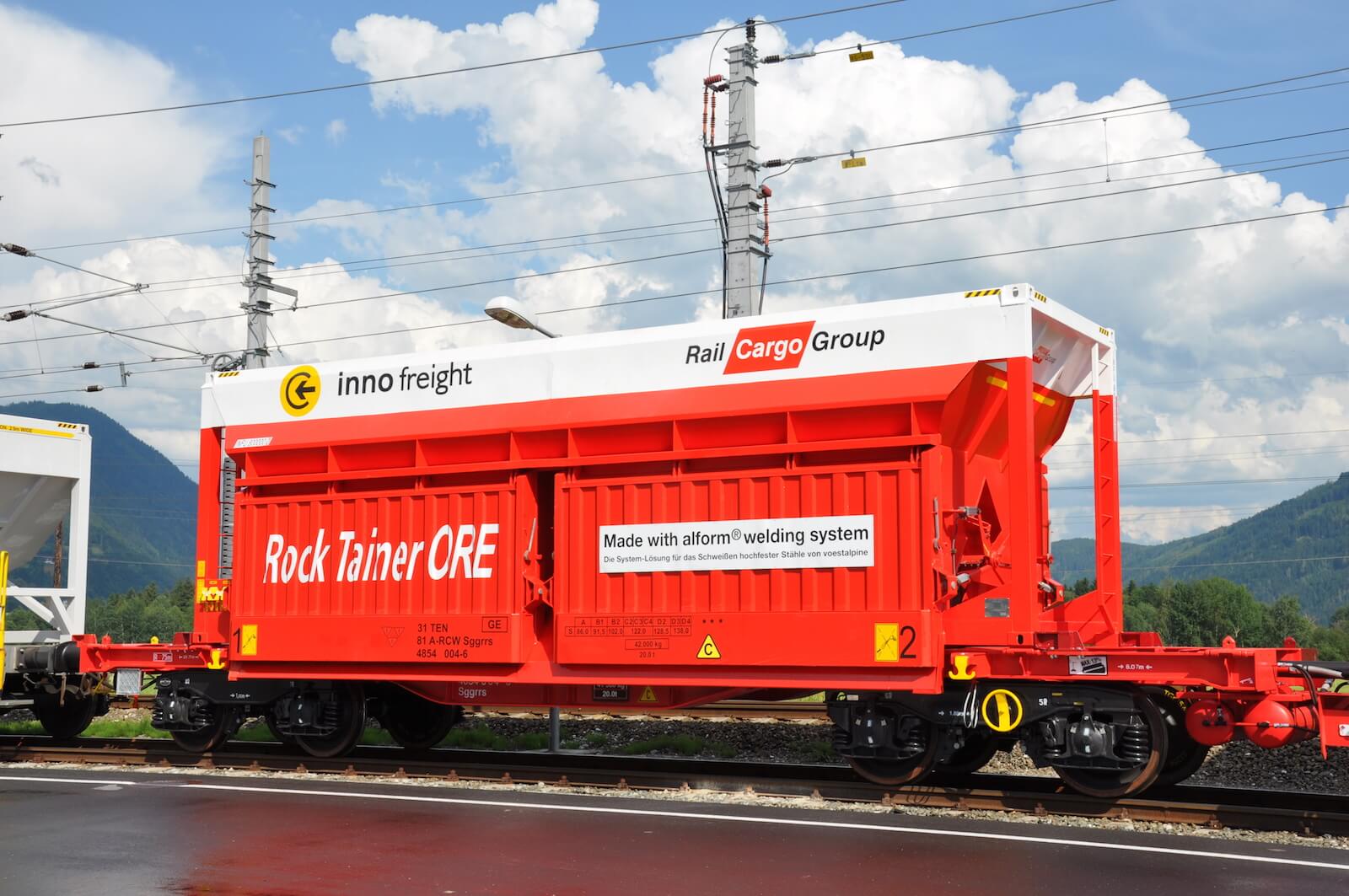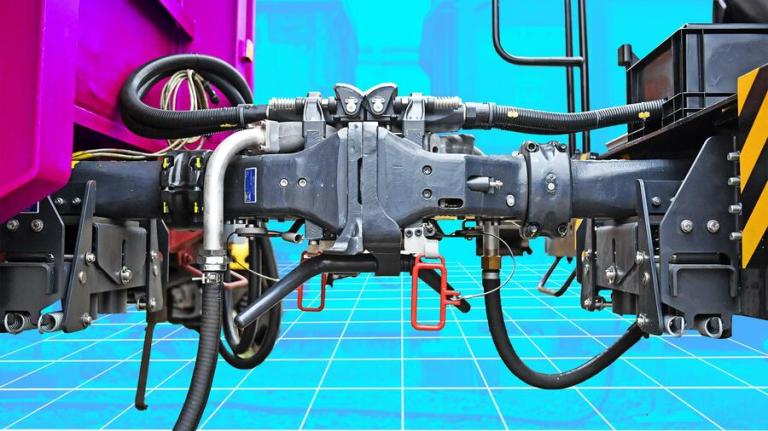Freight wagons have the particularity of responding to a specific industrial sector, such as chemicals or wheat. But the negative side of this specialization is that it leads to mono-use which causes empty returns. The modular wagon avoids this.
In order to achieve climate objectives, it is essential to avoid all forms of waste. Hypothetically, the stated amount of transported goods is from approximately 30 % made by single wagonload. It is a shipping goods technology in one railway wagon or in a limited wagon group carrying the same type of goods, accompanied by one bill of lading. Freight wagons, with their specialization, cause many empty runs, which is not only uneconomic but also reduces the real capacity for carrying goods by rail. So, how many freight trains are really full while some railway lines are saturated?
There are, of course, cases where a multi-purpose wagon is simply prohibited. For example in the chemical industry, a very dangerous sector where each wagon has its own specificity (transport of gas or oil, ambient transport temperature, tank pressure). It is obvious that a tank wagon going to the chemical centre in Lyon with detergent cannot return with a load of Côte du Rhône or Beaujolais (wines). In chemistry, empty runs are inevitable. But what about other industrial sectors?
This is what the Austrian company Innofreight studied as early as 2002. The Innofreight System focuses on innovative, patented solutions for goods shipping and logistic technologies. Originally, this company sought to improve the transport of wood, an essential sector in Central Europe, a region much more wooded than the Benelux or Northern France. With the WoodTainer system, the first rotary unloading had its debut in 2004. Since then, 15 years have passed, during which Innofreight has been able to contibute with ongoing innovations in the improvement of the rail logistics by using special containers. Innofreight’s journey oficially began in 2005 – with a first group of wagons supplying the Sappi paper mill in Gratkorn with wood chips. Soon after tthat, more wagons – and finally – entire trains followed. The WoodTainer XXL, which was presented in June 2005 in Ostrava, turned out to be the right product at the right time. By the summer of 2005, the new system was already in full operation. In spring 2006, 250 WoodTainers were already in use.
The special feature of Innofreight containers is that they are handled from underneath, via a fork, and can thus be rotated completely. A new 42-ton reachstacker provided the right twist for very fast unloading. By the end of 2006, another six large forklifts from the Swedish company Kalmar had expanded the Innofreight forklift fleet. The reachstacker is equipped with a calibratable scale, which eliminates the need for timeconsuming wagon weighing.

The number of customers in the wood, paper and pulp industries had been increasing rapidly. Innofreight supplied, among others, the chipboard plant of the Egger company in Unterradlberg north of St. Pölten, the Mondi company in Frantschach and M-Real in Hallein. In December 2006 Innofreight was able to deliver the 1,000th WoodTainer XXL to Papierholz Austria. The WoodTainer also proved its worth in the bitter cold of the polar winters in Scandinavia in 2007: the WoodTainer XXL transforms into the WoodTainer XXXL – the Swedish railway profile with its maximum width of 3,4 metres allows an volume increase up to 58 cubic metres. Innofreight therefore fully exploits the maximum loading volume and continues to use the XXL containers in Central Europe. Numerous new customers were added in 2007 and in 2008, an Innofreight subsidiary was established in Switzerland.
Nowadays, the company, in cooperation with haulers, made 1 million of containers movements a year with nearly 12,000 containers in circulation, 1,200 low-floor railway wagons classifed as InnoWaggon and 150 complete trains run on the railway network. The system is utilized in 14 countries and is operated by 90 international employees and 58 reachstacker with a front telescopic arm with a fork. Modularity and combinability of the Innofreight System solution guarantees a high level of capacity utilization of transport and shipping tools, flexibility and efficiency. The concept has been extended to other industrial sectors and containers were currently utilized for transport of agricultural products, construction materials, steel and other metallurgical products, energetic products and liquids.
The main advantage of the system is that the same wagon frame can be used for multiple uses. Innofreight not only installs containers, but also bulk materials containers, tanks or coil transport pallets, as shown in the photos below. Another important advantage of Innofreight containers is that the company has retained the ISO norms and standardised spreader grip corners designed for the maritime sector. These corners are perfectly visible and integrated on all types of containers.

Efficiency of the Innofreight System can be presented, not only by his modularity, but also by his loading capacity. Standard wagons of Fals Class (a special high-side wagon with a w-shaped floor for fast lading) have a loading weight of 55 tons, while the Innofreight twin-wagon unit has a loading weight of 126.9 tons. The difference in the loading weight with two wagons of Fals Class is therefore 16.9 tons in favour of Innofreight concept. That means that a train consisting of 40 wagon Fals wagons will have 340 tons less in comparison with an innofreight train. Raw timber for paper industry is transported by Eas bogie wagons (highside wagons) with a loading weight of 57 tons, when using the Innofreight System, a wagon unit can be loaded with four 20′-containers with a loading weight of 127 tons, which means higher transported weight by 13 tons in comparison with standard wagons.

It is important to distinguish this Innofreight system from another concept developed in Switzerland: ACTS. Although the ATCS also uses a low-cost modified flat wagon, it is primarily a concept developed for the waste sector. These containers have less volume and swivel at 45 degrees to be unloaded directly using a truck equipped with a hook arm. These containers are widely used for construction sites and public garbage containers parks. The ACTS concept is well used in the Alps but does not seem to have had much success on railways in other countries.
>>> See the ATCS concept by video
In recent years, the focus has been on wagons rather than containers. Also in Austria, the steel manufacturer Voestalpine and the state-owned operator ÖBB are producing a lighter wagon. A joint venture was signed last September between the customer and its carrier. This move paves the way for the further development of TransANT – the innovative, lightweight platform wagon, created by the two companies, that sets new standards of flexibility and modularity in the freight logistics market.
Launched in autumn 2018, TransANT is an wagon underframe that offers a payload advantage of up to four tons per wagon, thanks in part to the 20 per cent lighter chassis. Manufactured from the Voestalpine’s Alform high-strength steel, the platform wagons are being offered in a variety of lengths from 11 to 23 m. The innovation is found here in the modularity of the construction of the wagon. Four essential pieces are standardized and fit together according to customer’s needs. Apart from the shortest version designed to run as a coupled pair, the wagons will have identical headstock and crossbeam assemblies optimised for semi-automated manufacturing and configured for the future installation of a central autocoupler.

The desired length is then obtained and the design costs are greatly reduced, whatever the purpose of the wagon. The question of the crash test and the numerous standards governing the construction of these kit wagons is precisely what makes these Austrian vehicles so technologically new. Voestalpine has played a key role here in many innovations, for example in the area of bodywork welding.


Looking at the latest developments, it would seem that the battle for the best wagon is on. DB Cargo, allied with the leasing company VTG, also presented a similar modular wagon last September. Called « m² », this wagon is intended to provide a multifunctional design which can be customised to meet the requirements of individual customers. According to the promoters, the aim is to optimise wagon parameters such as weight, mileage and cost. It can be found here some options of the Austrian TransANT wagon. Standard components such as bogies, wheelsets and tread or disc brakes can be fitted as appropriate for each application.

VTG and DB Cargo worked closely together within the framework of the Federal Ministry of Transport’s « Innovative Freight Car » project, which was completed at the beginning of 2019.
These examples show how important it is for the state to invest in national R&D by relying on the entire industry, including private industry, rather than on projects carried out by a monopoly company on its own. Heiko Fischer, Chairman of the Board of Management of VTG AG, explains: « The past has shown that only together can we make progress in rail freight transport and strengthen it against the road. With the modular wagons that we are developing as part of the project, we will continue to improve the range of services for our customers and increase the attractiveness of the railways ». A whole series of other technological innovations, such as automatic couplings and digital innovations currently being tested, now need to be added to these innovative wagons. The result will be wagons that finally no longer look like those built 200 years ago…
Sources:2010 – Transport Research Market Uptake (Market-up) – Deliverable: D 3.1 – Selected case studies on transport innovation: R&D initiatives and market uptake of results
2016 – European Commission – Design features for support programmes for investments in last-mile infrastructure
2019 – Innofreight, annual review
2019 – Cordis Europa – Innovative modular wagon technology encourages the switch to rail freight
2020 – Researchgate – Multimodal Transport as a Substitution for Standard Wagons
 Is automatic coupling on freight wagon will become reality?
Is automatic coupling on freight wagon will become reality?
09/07/2020 – Europe is finally testing an automatic coupling for its freight trains. But now with digital attributes. This coupling will make it possible to operate « intelligent trains »
![]()


Vous devez être connecté pour poster un commentaire.